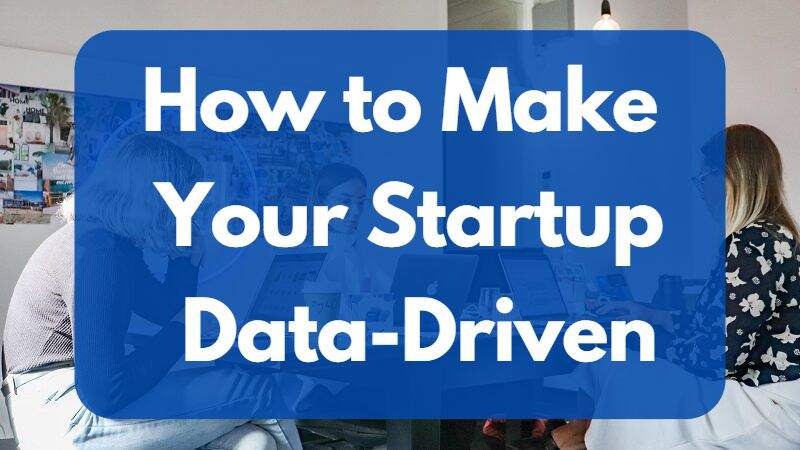Data has quickly become one of the most important resources for modern business, yet HBR found that 52% of businesses still fail to focus on becoming data-driven. Businesses that do obtain data-driven status are 3x more likely to report significantly improved decision-making, according to Think With Google.
Thinking about data early on for startups and young businesses is potentially critical to success. Becoming “data-driven” doesn’t happen overnight, but putting strategies in place early on is the key to future success.
In this article, we are going to discuss the best ways to make your startup more data-driven
5 Effective Strategies to Implement Data-driven Approach in Your Startup
Here are five strategies for making your startup more data-driven:
1. Know Your Audience
No startup should assume who its audience is. For example, just because you’re operating in a space that you feel appeals to millennials doesn’t mean your buyers are all millennials. Or, the customers for your child’s toy brand might actually be 50-something parents, an audience that you’re not targeting.
Another example of a misplaced audience is B2B buying. If you’re selling a corporate B2B product, you might assume your audience is 40-year-olds with a C-Level or equivalent background. In reality, Think With Google found that millennials aged between 18 and 34 account for some half of B2B buyers, whereas around 81% of non-C-level employees have a say in B2B purchases.
The Google Analytics ‘Audience’ tab provides multiple data points that describe your site’s traffic. You want to look at the demographics to find your content and interact with your site as repeat visitors. There are three important tabs:
- The demographics tab provides age, location, gender, and other demographic data.
- Geo, for delving into locational data.
- The Interests tab enables you to find common ground between visitors.
Check your data against other customer data you have, e.g., purchases or B2B data stored in a CRM. You can also check your social media analytics. If you want, you can aggregate all data that identify your audience and analyze it using data visualizations to find out who they really are, enabling you to better target marketing and sales activity.
2. Focus On Events
Think With Google found that 87% of online purchasing journeys start with an organic search. You want to know when a customer first touches your business, marking the first point on their potential journey toward conversion.
Collecting event data enables you to track and analyze the following activity:
- Track campaign activity. For example, UTM parameters tagged to URLs can track email and social media campaign activity.
- Brand sentiments and mentions. Social media listening lets you track conversations surrounding your brand and competitors. This allows you to compete directly with competitor releases and rapidly respond to customer complaints and queries.
- Attribution: If you’re using multiple touchpoints, you need to know what a buyer’s journey is. For example, if you know that 70% of your new customers come from a specific marketing channel and campaign, this could tell you you might be able to pull that figure up a bit higher by investing more into that channel.
By describing a customer’s journey as a series of events, you can orchestrate that journey to influence channel performance and increase conversions.
3. Evidence-Based Culture
Data-driven startups make decisions based on evidence. Sure, instinct and acumen always play a role in modern business, but real-life decisions should be based on evidence. For example, if you survey 100 customers and find they say the same thing, but you don’t agree and go against the evidence, you’re taking a huge risk.
Similarly, if a product you initially believed was just a spin-off or afterthought of another is performing best, consider letting go of your main product and pivoting to the new one.
Following the evidence is especially important when it comes to marketing spending. Experiment with different channels and different levels of investment.
While you might think investing heavily in Google Ads is appropriate for your business, you might find that similar spending on TikTok exhibits greater performance. If you encounter such situations that challenge your preconceptions, follow the evidence.
However, bear in mind that you can solidify evidence by conducting experiments, A/B tests, etc. Create marketing mix models and experiment with different levels of spending across various channels to forecast sales potential.
4. Invest in Tools, But Watch Out for SaaS Sprawl
It might be tempting to go out and subscribe to loads of SaaS tools – most teams use as many as 40 to 60 on average! However, while many SaaS tools are extremely useful, it’s best to build a list from the ground up to avoid SaaS sprawl. SaaS sprawl occurs when businesses invest in too many revenue-sucking SaaS tools that go underutilized.
For example, it might be wise to invest in some of the following:
- Accounting software (e.g. Xero)
- Team and project management software (e.g. Monday)
- Social media scheduling software (e.g. Buffer)
- Email automation (e.g. Mailchimp)
- CRM (e.g. Salesforce)
- Marketing automation (e.g. HubSpot)
- Cloud databasing (e.g. AWS, GCP, or Azure)
- Customer service (e.g. Zendesk)
The list could go on, so create a list to prioritize tools that address pain points now. Curate your SaaS tool list with care to take maximum advantage of what you need rather than signing up for everything you might need.
5. Invest in a Data Stack
Building a modern data stack is essential for growing startups. Once you’re attracting customers and investors, it’s time to invest in tools for long-term growth.
The modern data stack contains tools that enable the following:
- Data ingestion: Extracting data from products and channels.
- Data transformation: Transforming different data into clean, usable data for warehousing and action.
- Data warehousing: Centralizing that data for analysis and action.
- Data analysis: Analyzing data for segmentation, sales funnel visualization and customer journey orchestration.
- Data activation: Deploying data into everything from marketing automation to rewards programs and recommendation engines.
To do this, you’ll need to combine warehouses with ETL/ELT tools and platforms for analysis (e.g. Tableau) and action/orchestration (e.g. Segment).
Conclusion
By carefully integrating data into decision-making, startups can take full advantage of their resources. The end goal is to create a startup that drives evidence-based decisions from clean data.
Building such a stack relies on shrewd investment and decision-making by data scientists, engineers, and other data practitioners. The strategies mentioned above can hopefully help your startup become more data driven.

Aditya is a seasoned JavaScript developer with extensive experience in MEAN stack development. He also has solid knowledge of various programming tools and technologies, including .NET and Java. His hobbies include reading comics, playing games, and camping.

